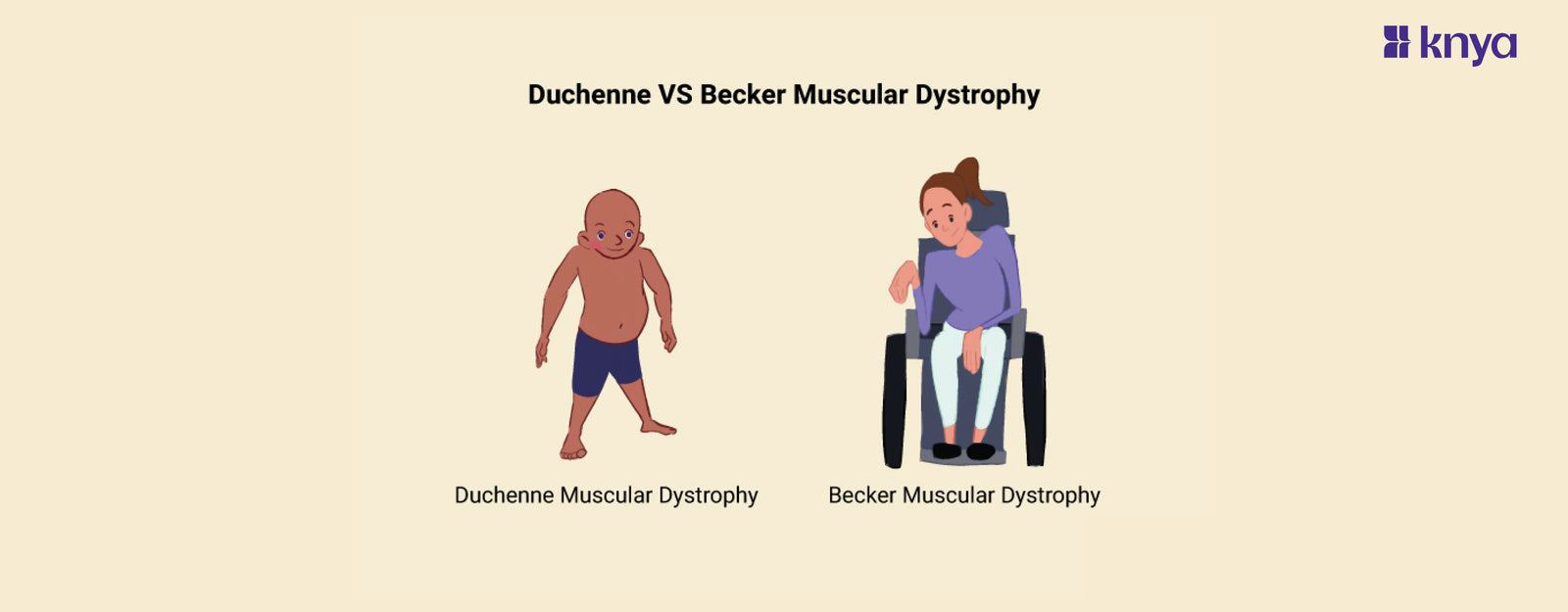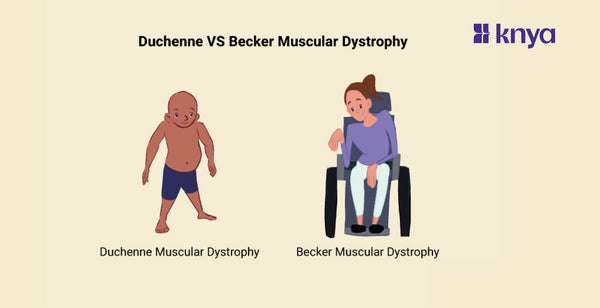Duchenne and Becker Muscular Dystrophy are muscle-wasting diseases caused by anomalies in the dystrophin gene. Duchenne Muscular Dystrophy, the more severe variant, results in the entire lack of functional dystrophin, causing fast muscular weakening beginning in early childhood. Individuals with Becker Muscular Dystrophy still have some functioning dystrophin, which causes lesser symptoms later in life and frequently allows for extended ambulation. While both affect predominantly males and have similarities, DMD advances considerably quicker, affecting cardiac and pulmonary function, whereas BMD's slower course may result in a longer lifetime.
Duchenne Muscular Dystrophy
- Affects boys primarily, caused by a mutation in the dystrophin gene.
- Progressive, starting in early childhood, impacts walking, running, and daily activities.
- Lack of dystrophin protein leads to muscle fiber injury and wasting.
- Can affect heart muscle and respiratory function, requiring careful management.
Becker Muscular Dystrophy
- Caused by different mutations in the same gene, but milder and progresses slower.
- Symptoms typically appear in teens or young adulthood.
- Muscle weakness varies by individual, impacting mobility and function to different degrees.
- Can affect heart muscle but usually less severely than in Duchenne Muscular Dystrophy
Order the Best Jogger Scrub from Here!
Difference Between Duchenne and Becker Muscular Dystrophy
Duchenne muscular dystrophy (DMD) and Becker muscular dystrophy (BMD) are two hereditary neuromuscular illnesses caused by mutations in the dystrophin gene on the X chromosome. Here are a couple of differences between Duchenne and Becker muscular dystrophy.
|
Differences |
Duchenne Muscular Dystrophy |
Becker Muscular Dystrophy |
|
Severity |
Typically more severe |
Less severe compared to DMD |
|
Age of onset |
Symptoms usually manifest at ages 3 to 5 |
Symptoms may appear later, often between ages 5 to 15 |
|
Rate of progression |
Rapid progression |
Slower progression |
|
Dystrophin production |
Little to no dystrophin produced |
Reduced or abnormal dystrophin production |
|
Physical abilities |
Loss of ability to walk by early teens |
Ability to walk may be retained into adulthood |
|
Cardiac involvement |
Common, earlier onset and more severe |
Common, but usually later onset and less severe |
|
Cognitive function |
May experience cognitive impairments |
Typically does not affect cognitive function |
|
Creatine kinase (CK) levels |
Very high |
Lower compared to DMD |
|
Genetic mutation types |
Large deletions or duplications |
Point mutations or small deletions/duplications |
|
Life expectancy |
Shortened lifespan, often dying in 20s or 30s |
Varies widely, some individuals may live into 40s+ |
Browse Best Scrubs Collection
What is Duchenne Muscular Dystrophy?
Early childhood weakness leading to progressive muscle loss. Duchenne muscular dystrophy , affecting boys almost exclusively, is caused by a lack of the dystrophin protein, crucial for muscle function. Symptoms like difficulty walking and enlarged calves start around age 2-3, progressing to affect heart and respiratory muscles. Though there's no cure, therapies manage symptoms and improve lifespan.
Key Features of Duchenne Muscular Dystrophy:
- Symptoms often occur between the ages of two and six, with muscular weakness moving from the legs to the arms and chest. Walking difficulties appear at the age of ten, and wheelchair dependency is required by adolescence.
- Duchenne muscular dystrophy causes significant muscular weakness and wastage, especially in the legs, hips, and shoulders. This causes difficulties ascending stairs, standing up, and, ultimately, breathing issues.
- Up to 30% of people with DMD have mild to severe intellectual impairment, which affects learning and memory.
- DMD can cause cardiomyopathy (heart muscle weakening) and respiratory difficulties, necessitating specialised treatment and monitoring.
What is Becker Muscular Dystrophy?
Milder and later-onset muscle weakness compared to Duchenne muscular dystrophy, the muscular weakness is milder and develops later. Becker muscular dystroph also involves dystrophin problems, although with some residual protein function. Symptoms such as frequent falls and muscular tiredness often start in adolescence or age, advancing more slowly than DMD. While cardiac and pulmonary difficulties may emerge, BMD has a longer lifetime and a less severe impact.
Key Features of Becker Muscular Dystrophy:
- Symptoms commonly develop between late childhood and early adulthood, and muscular weakening progresses more slowly than in DMD. Walking issues may not develop until the late teens or twenties.
- Becker muscular dystrophy causes milder and slower-progressing muscle weakening, particularly affecting the legs and shoulders. Individuals may maintain some ambulatory capacity throughout maturity.
- Becker muscular dystrophy, unlike DMD, is not associated with cognitive impairment, and patients normally have adequate intellectual ability.
- Cardiomyopathy and respiratory problems are less prevalent with BMD, although monitoring is still necessary.
Shop Best Lab Coats from Here!
Similarities Between Duchenne and Becker Muscular Dystrophy
- Both Duchenne muscular dystrophy (DMD) and Becker muscular dystrophy (BMD) are inherited in an X-linked recessive manner, which means they mostly affect men, however females can carry and pass on the gene mutation.
- Both disorders are characterised by gradual muscular weakening and atrophy, which causes difficulty with movement and everyday tasks.
- Individuals with DMD and BMD may eventually need to use a wheelchair to go around.
- Respiratory muscle weakness is frequent in both DMD and BMD, which can cause breathing difficulty and the requirement for respiratory assistance.
- Corticosteroids, such as prednisone or deflazacort, are widely used to decrease the course of DMD and BMD, however their effects may differ according to the person.
- Physical therapy and other supporting measures are crucial components of DMD and BMD care because they aid to preserve muscular function and mobility.
- Because both disorders are caused by mutations in the same gene, research and clinical trials targeted at discovering DMD treatments or therapies may also assist BMD patients.
While both Duchenne and Becker Muscular Dystrophy (DMD and BMD) are caused by dystrophin gene mutations, their effects on muscle function and disease development are not the same. DMD, caused by a total lack of functioning dystrophin, presents in early childhood as progressive muscular weakening and loss, frequently leading to wheelchair reliance by adolescence. BMD, on the other hand, allows for some dystrophin production, resulting in a milder course with symptoms appearing later in adolescence and a longer decline, generally sustaining ambulation into maturity. Despite these variations, both kinds face the problems of growing muscular weakening, which can impair cardiac and respiratory function. Understanding these disparities is critical for correct diagnosis, care, and continuing research efforts targeted at improving outcomes for people with DMD and BMD.
| Check out More Articles | |
| Difference Between Tendon and Ligament | |
| Difference Between Seizure and Epilepsy | |
| Difference Between Hypothyroidism and Hyperthyroidism | |















